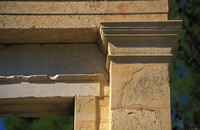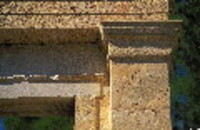| dc.coverage.spatial | Site: Epidaurus Theater (Epídhavros, Peloponnese, Greece) | en_US |
| dc.coverage.temporal | ca. 350 BCE (creation) | en_US |
| dc.creator | Polykleitos | en_US |
| dc.date | -400--300 | en_US |
| dc.date.accessioned | 2013-05-22T19:14:30Z | |
| dc.date.available | 2013-05-22T19:14:30Z | |
| dc.date.issued | -400--300 | en_US |
| dc.identifier | 220708 | en_US |
| dc.identifier.other | archrefid: 676 | en_US |
| dc.identifier.uri | http://hdl.handle.net/1721.3/128632 | |
| dc.description | Parados (one of the paradoi or monumental gateways which gave actors access to the stage); the pilaster capital; The most important surviving structure at Epidauros is without doubt the great theatre. Its auditorium, still virtually intact, was built in the second half of the 4th century BCE. The seating, of local limestone, is divided into lower and upper sections, the lower extending beyond the upper, perhaps as a result of later work. The stage building is ruined, though its essential arrangement, with side ramps leading to the stage, is clear enough. Pausanias (Guide to Greece II.xxvii.5) attributed the theatre (and the thymele) to Polykleitos. This cannot be the 5th-century bc Argive sculptor but may be his grandson. Source: Grove Art Online; http://www.groveart.com/ (accessed 12/10/2007) | en_US |
| dc.format.medium | marble | en_US |
| dc.rights | © Scott Gilchrist, Archivision, Inc. | en_US |
| dc.subject | architectural exteriors | en_US |
| dc.subject | Performing arts | en_US |
| dc.subject | Classical | en_US |
| dc.title | Epidaurus Theater | en_US |
| dc.title.alternative | Theater at Epidauros | en_US |
| dc.type | image | en_US |
| dc.rights.access | Licensed for educational and research use by the MIT community only | en_US |
| dc.identifier.vendorcode | 1A3-G-E-1-D6 | en_US |
| vra.culturalContext | Greek (ancient) | en_US |
| vra.technique | construction (assembling) | en_US |
| vra.worktype | theater (building) | en_US |
| dc.contributor.display | Polykleitos (Greek (ancient) architect, active ca. 350 BCE) | en_US |



